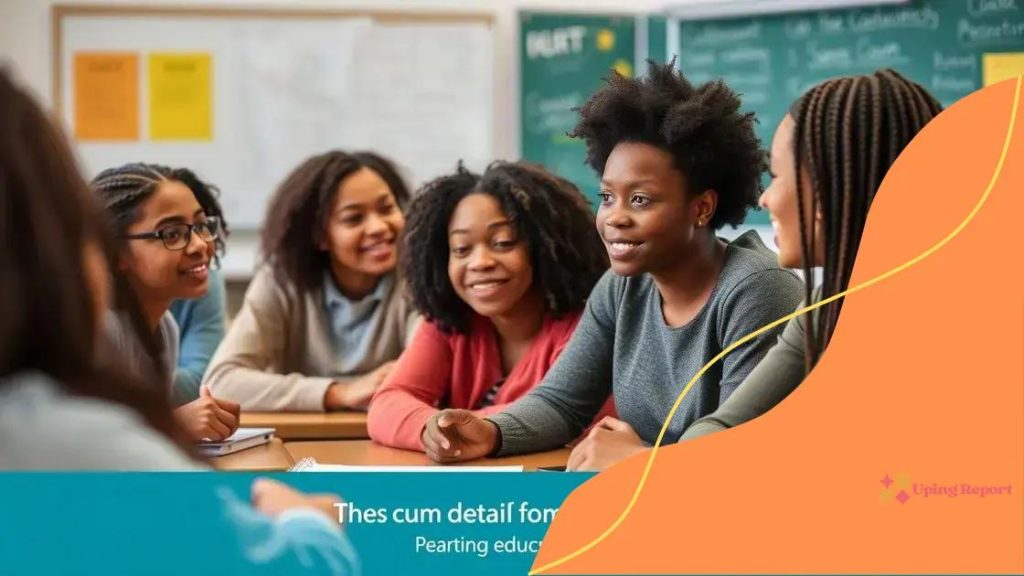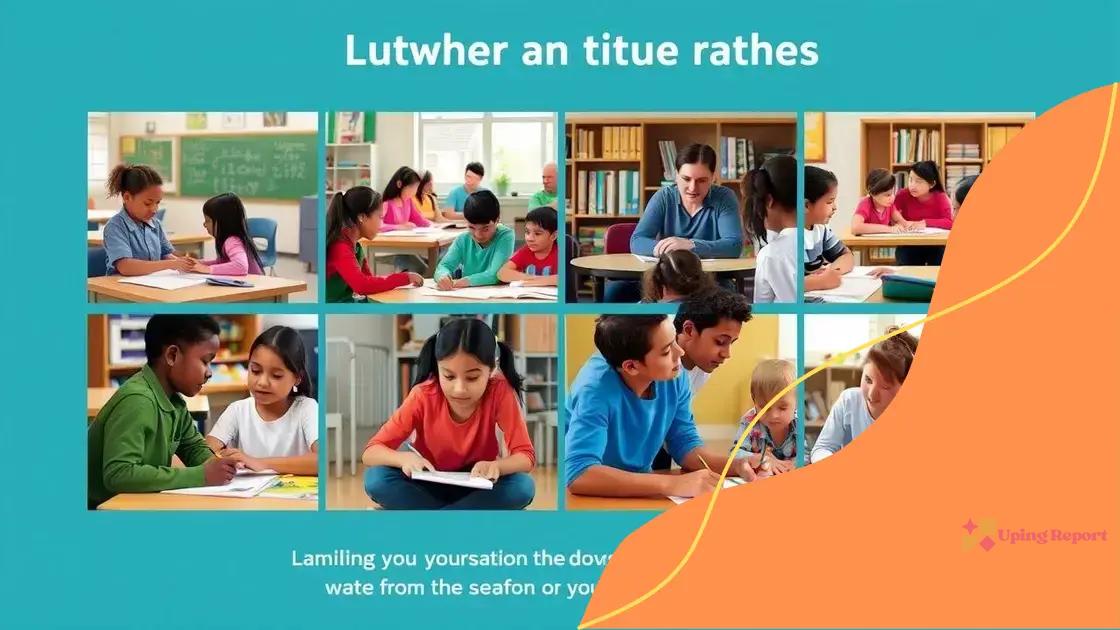School choice policy updates: what you need to know

School choice policies enable families to select from various educational options, including charter, private, and homeschooling, providing opportunities for tailored learning experiences that meet individual student needs.
School choice policy updates have become a hot topic in education today. With changing laws and new options emerging, it’s crucial to stay informed. How do these updates affect your child’s education and the choices available to you?
Understanding school choice policies
Understanding school choice policies is essential for parents and students alike. These policies allow families to select different educational options beyond their assigned public school. With several choices available, it’s important to grasp how these policies shape the educational landscape.
Types of School Choice Options
There are various types of school choice options, each with its distinct features and benefits. For instance, families can consider:
- Charter schools, which operate independently but receive public funding.
- Magnet schools, designed to attract students with special interests or abilities.
- Private schools, which often require tuition but offer specialized programs.
- Homeschooling, where parents take full control of their child’s education.
These alternatives encourage competition, ultimately aiming to enhance overall education quality. However, navigating these choices can be complex.
Impact on Families
The rise of school choice policies impacts family decisions significantly. Parents seeking better educational environments for their children can find themselves weighing the pros and cons of each option. Accessibility is a crucial factor; not all families have equal access to quality information about school choice policies.
Moreover, understanding how each option fits your child’s needs can help in making informed decisions. With the right resources, families can choose schools that align with their child’s strengths and challenges.
In addition, many states have implemented funding programs to assist families in accessing these diverse educational choices. Scholarship programs, vouchers, and tax credits are some methods that facilitate enrollment in non-public institutions.
Recent changes in legislation
Recent changes in legislation regarding school choice policies have introduced new opportunities and challenges for families. These changes can significantly affect the educational landscape, providing more options for students while also creating a complex environment for decision-making.
Key Legislative Updates
Several key legislative updates have been introduced across various states. Understanding these developments is crucial as they directly impact how families approach choosing schools. Some of the notable changes include:
- Increased funding for charter schools, allowing for more resources and facilities.
- Expanded eligibility criteria for voucher programs, making financial aid available to more families.
- New regulations on how public schools report performance, promoting greater transparency.
- Introduction of scholarship programs specifically targeting underprivileged communities.
These updates aim to foster greater competition among schools, encouraging them to improve their offerings. However, with more options comes the need for families to stay informed about their choices.
Implications for Students
The implications of these legislative changes are profound for students. Increased funding can lead to better resources and programs, benefiting students’ overall learning experiences. Families now have more avenues to explore, whether it’s a specialized program in a charter school or a traditional private education.
As school choice becomes more prevalent, it will be important for parents to evaluate each option carefully. Not all schools offer the same quality of education, and understanding the fine print of new policies can help in making the best choices.
Additionally, the impact of these changes will vary widely depending on local district policies and state funding. Parents should actively seek out information and engage with school administrators to ensure they understand the available options.
Impacts on students and families

The impacts of school choice policies on students and families are significant. These policies open up different educational opportunities, but they also introduce new challenges. Understanding these effects can help families navigate their options better.
Benefits for Students
Students often benefit from school choice as it allows them to find an educational environment that best fits their needs. For example, students can pursue specialized programs that match their interests, such as arts or sciences. This personalized approach can enhance engagement and lead to better academic outcomes.
Moreover, competition among schools to attract students often results in improved facilities and resources, benefiting all students.
- Access to specialized programs tailored to unique talents.
- Potential for smaller class sizes in charter or private schools.
- Enhanced extracurricular opportunities, which can aid in overall development.
While these benefits are appealing, families must also be mindful of the challenges.
Challenges Faced by Families
With increased options come complexities. Navigating the many available choices can be overwhelming for families. Understanding how to apply for programs, knowing eligibility requirements, and comparing school performances can all add stress to the decision-making process. Additionally, transportation may pose a challenge, as not all families can easily reach their chosen school. Funding disparities can also affect the availability of quality options in different regions.
Financial implications are another critical consideration. Although vouchers and scholarships can help, not all families qualify, and tuition for private schools can be a barrier. These factors can limit access to quality education and create disparities among families. It’s crucial for parents to evaluate their choices carefully and understand the full picture when considering school choice policies.
Key considerations for parents
When exploring school choice policies, parents must consider several key factors that can impact their children’s education significantly. Each decision can have lasting effects, making it essential to be well-informed.
Understanding Your Options
Parents should first understand the different educational options available to them. From public schools and charter schools to private institutions and homeschooling, the choices can be vast. Each option has unique benefits and drawbacks, which parents need to weigh carefully. For example, charter schools may offer specialized programs, while private schools can provide smaller class sizes.
- Research school performance metrics, including test scores and graduation rates.
- Consider the curriculum each school offers, ensuring it aligns with your child’s learning style.
- Visit schools and attend open houses to get a feel for the environment.
This research can help parents make informed choices that align with their child’s needs and aspirations.
Financial Considerations
The cost of education also plays a crucial role in the decision-making process. While public schools are funded through taxes, private and charter schools often require tuition payments. Parents should explore available financial aid options, such as scholarships or vouchers, which can help ease the burden of tuition fees. Understanding the financial implications is vital, as some families may face challenges in affording quality education for their children.
Additionally, consider hidden costs like transportation and extracurricular activities that may arise with certain school choices. These factors can influence the overall affordability of a school.
Long-Term Impact
It’s also important for parents to think about the long-term effects of their choices. Will the selected school prepare your child for future opportunities? Look at the school’s track record of college admissions or vocational training. Engaging with other parents and alumni can provide insights into how well the school prepares students for life beyond graduation.
Every choice comes with its own set of challenges and advantages. Parents must weigh these carefully, keeping their child’s future success in mind while navigating the options available through school choice policies.
Future trends in school choice
Future trends in school choice are evolving as education continues to adapt to societal needs. Understanding these trends can help parents and educators prepare for the changing landscape of education.
Increasing Flexibility in Education
A notable trend is the increasing flexibility in educational options. More states are adopting policies that allow families to customize their children’s education. For instance, some schools are offering hybrid models that combine in-person and online learning. This flexibility can cater to different learning styles and help students learn at their own pace.
- Online education platforms providing diverse curriculum access.
- Flexible schedules that accommodate family commitments.
- Programs that allow students to switch between different educational paths easily.
As a result, students may find themselves in environments that better suit their individual needs, promoting more effective learning experiences.
Focus on Inclusivity
Another emerging trend is a stronger emphasis on inclusivity within school choice policies. Many lawmakers are pushing for regulations that ensure all families, regardless of socioeconomic status, can access quality education options. This push is essential to leveling the playing field and providing equal opportunities for students from diverse backgrounds.
Districts are increasingly implementing policies that encourage diversity in school admissions, thus enhancing the educational experience for all students.
Technology Integration
Technology continues to transform education, and school choice is no exception. The integration of technology into classrooms is not just about having computers or tablets. It involves using innovative educational tools and personalized learning software to engage students better.
Future schools are likely to adopt advanced technologies that enhance learning outcomes, including data analytics to tailor instruction to individual student needs. Moreover, virtual reality and gamification may become common tools in the classroom, making learning more interactive.
These trends indicate that the future of school choice will bring more opportunities, making it crucial for families to stay informed and ready to adapt to new educational landscapes.
In conclusion, understanding school choice policies is vital for parents navigating their child’s education options. These policies offer many opportunities, including flexible learning environments and increased resources. However, families must be aware of the complexities involved in making informed decisions. By staying informed about legislative changes, considering the impacts on students, and anticipating future trends in education, parents can better advocate for their children’s educational needs. Embracing these shifts will help families maximize the potential benefits of school choices available to them.
FAQ – Frequently Asked Questions about School Choice Policies
What are school choice policies?
School choice policies allow families to select educational options for their children, including traditional public schools, charter schools, private schools, and homeschooling.
How can school choice benefit my child?
School choice can provide your child with customized educational experiences that match their individual needs and learning styles, potentially leading to better academic outcomes.
Are there financial assistance options for private schools?
Yes, many states offer scholarships, vouchers, and financial aid programs to help families afford private school tuition and other educational expenses.
What should parents consider when choosing a school?
Parents should evaluate factors such as school performance, curriculum offerings, location, financial implications, and the school’s approach to inclusivity and technology integration.
